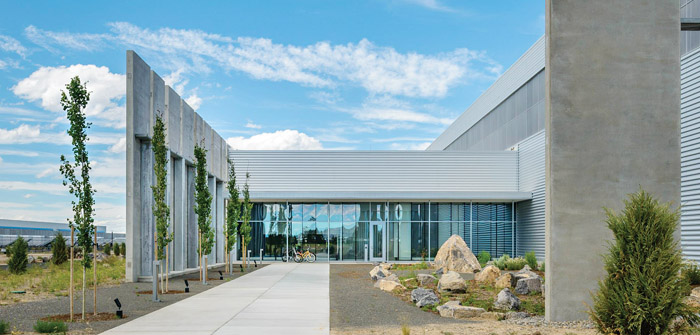(Photo above: Facebook Data center | Photo by Alan Brandt)
Prineville is positioned well for the future as it continues transitioning away from a natural resources economy, according to community leaders.
City Manager Steve Forrester said the economy has improved greatly from 2011, when unemployment was 19 percent. The rate is now below six percent.
He added that Facebook and Apple data centers locating in Prineville was “a game changer” for the town.
Their two million square feet of construction pumped $3 billion into the local economy, Forrester said. The centers have added about 400 direct jobs and continue to grow, with about half of the positions filled by Crook County residents.
At the same time, what Forrester called “our foundational business sectors” such as the millwork industry, tire distribution and agriculture have steadily
increased employment.
City Engineer Eric Klann says the recession was especially hard on the town, but Prineville is rebounding with a diversified economy. Still, he said there’s a longtime mindset in Prineville that hasn’t totally been erased.
“The data centers are definitely helping and moving us in the right direction,” Klann said. “I feel that the economic health of Crook County is improving. However, there is a large population in Prineville that grew up in our natural resource based economy.
“For many years people could leave high school and immediately go to a mill employing 500 people to acquire a family wage job. People are somewhat still expecting this. Unfortunately, these jobs have moved offshore and are no longer available.”
INFRASTRUCTURE PROJECTS
The city recently finished its effluent disposal wetland at the wastewater treatment plant, which will stabilize rates into the future, he said. The facility reduces future treatment costs while creating 120 acres of wetlands, two miles of improvement to the Crooked River, over five miles of trail and other amenities.
“We’re very excited to finally have this system online,” Klann said.
Other significant projects include development of a 2.5 megawatt hydroelectric facility on Bowman Dam. The city is partnering with Crook County and Ochoco Irrigation District to provide renewable energy that will support more than 1,400 homes. Klann said it will be online by 2022 “if all things go right.”
The City of Prineville has completed about sixty percent of the design of an industrial wastewater re-use plant. When completed, the facility will cleanse wastewater “beyond drinking water quality,” Klann said. Construction is scheduled to begin in the fall and isn’t expected to affect residential customer rates while benefitting the
business community.
“Who would have thought that the small City of Prineville will have one of the most technically advanced wastewater treatment plants in the world?”
The City is developing a feasibility study for aquifer storage and recovery. That method uses the natural water storage capabilities of underground aquifers as a cost-effective, scalable and ecologically friendly water storage alternative to traditional options such as above-ground reservoirs.
“This approach allows for use of stored water during periods of high demand, thereby reducing stress on native water sources,” Klann said. “In addition, it provides for a readily available reservoir for use in the event of drought or supply interruption.”
DATA CENTER DEVELOPMENT
Another project will allow safer access to the airport industrial area through construction of a roundabout at the intersection of Highway 26 at Tom McCall Road. That involves cooperation between the City, county and Oregon Department of Transportation.
But it’s the data centers that have put Prineville on the map in its new economic direction. Forrester, the city manager, said June 8 during an address to a civic group that more such companies are considering Prineville as a potential home.
“There are other big name companies who are actively interested in our community to invest here other than Facebook and Apple,” Forrester said, adding he could not release company names at this time.
Prineville’s electricity supply is a key to more data center development. Forrester said Bonneville Power Administration (BPA) is planning electrical line updates in the next couple of years to allow existing Prineville firms to expand. However, he warned that BPA must construct a new line in the next five to eight years if Prineville’s growths —
especially among data centers — can proceed as civic leaders hope.
“We want to get that process started now,” Forrester said.
He described the electricity supply as good for current needs, but Oregon’s congressional delegation must continue urging BPA to build a new line to provide power for upcoming years.
SunPower is another bright development in Prineville. The solar farm is said to be the largest solar complex in Oregon, Forrester noted. He mentioned a young man who graduated from Crook County High School and went on to Oregon State University before returning to Prineville for a “great job” developing renewable energy.
“SunPower would not be building renewable energy in Prineville without the data centers, and the ancillary jobs being created for renewable energy,” he said.
NEW OPPORTUNITIES
Caroline Ervin of Economic Development of Central Oregon (EDCO) sees Prineville’s economy growing stronger. She said the average annual wage jumped from just over $31,000 in 2009 to almost $45,000 last year. There’s room to grow even more, she emphasized.
“We have many attributes that make us attractive for companies to move, start or grow here,” she said. “Some of those attributes include infrastructure capacity, low-priced industrial land, reliable low-cost power and a business friendly local government.”
Some top employers include Les Schwab, Contact Industries, St. Charles, Brasada Ranch and SMAF/Western Heavy Haul, Ervin added.
She acknowledged that sufficient housing will likely remain a challenge in Prineville, as it is throughout Central Oregon. Prineville’s vacancy rate has frequently dipped below one percent during the past few years.
Meanwhile, Prineville’s move toward diversification could include a new industry that not only would improve forest health but provide fodder for a fuel source that could help replace coal. Matt Krumenaur, CEO of Oregon Torrefaction, says a test burn sponsored by Portland General Electric at the Boardman coal-fired plant demonstrated that woody debris from small-diameter logs could hold economic benefits.
“We did a 100 percent test burn at the (Boardman) plant and it was stable and operated well,” Krumenaur said. “There is drastically less sulfur and mercury compared to coal, so it is cleaner from that perspective. Now it’s a matter of finding out what the Boardman facility could pay for biomass.”
The process of torrefaction turns biomass into a dry material capable of being ground up and burned as fuel.
Krumenaur noted that Ochoco Lumber is part owner of Oregon Torrefaction LLC. The company has received funding of $10 million toward the new energy source, including an appropriation from the U.S. Forest Service.
If woody fuel in the forests is removed, Krumenaur said, it could drastically reduce the amount of money spent to combat wildfires. He said the bill for fighting summer fires is about $3 billion annually.
EDCO is giving Oregon Torrefaction help with site selection for a possible plant near Prineville.
“EDCO has been really good to work with, very responsive,” Krumenaur said.
The CEO realizes his vision won’t be realized overnight because replacing coal with biomass is an emerging market at this point. However, the potential benefits are worth the effort, he believes.
“We’re not tilting at windmills,” Krumenaur said. “We know it will be hard and the economics are challenging, but we are really focusing on that mission. Some of the early stage activities are probably not going to be the most profitable, but if we can create a market that’s going to be a pretty impressive accomplishment.”





